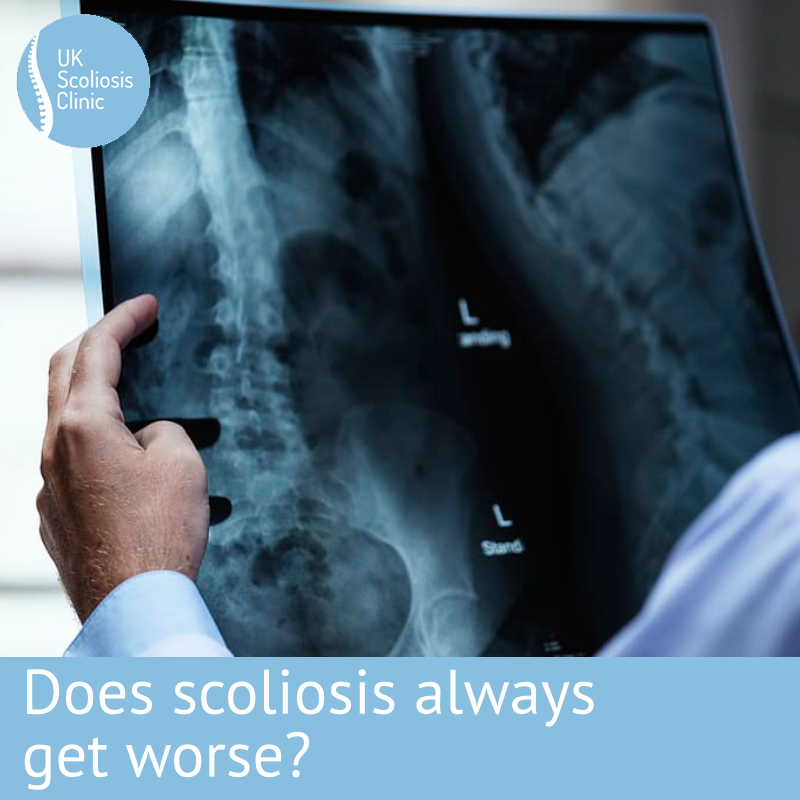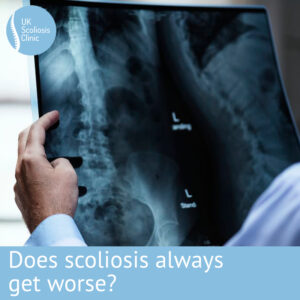
One of the first questions which many people ask when they are diagnosed with scoliosis is “will it get worse?” There’s also a lot of misconceptions around this issue to deal with. It’s true that some scoliosis cases do simply stop developing – but despite what you might read on the internet, this is very rare. Today, we understand scoliosis much better than ever before, and so while we can’t fully explain the condition, we can now make some very sensible assumptions about its likely progression.
This week, let’s look at some of our current best information on this question.
Scoliosis development
Firstly, it’s important that we outline exactly what we mean by “worse” in this situation. Scoliosis is a condition which causes a host of unpleasant symptoms, ranging from physical deformity to problems breathing and, perhaps most impactful for most people, a drastic impact on self-confidence. While these are all perfectly valid ways of understanding how ”bad” scoliosis is, in a clinical setting we tend to focus on an accepted measurement called a “cobb angle”. A Cobb angle measures the deviation of the spine from normal, such that a more pronounced scoliotic curve is said to have a greater cobb angle, or be of a greater magnitude. It is generally true that as cobb angle increases, symptoms will also become more severe. So, what do we understand about the factors which seem to predispose individuals to a greater increase in this regard?
Growth potential
Growth potential – that is to say, how much growing a skeleton has already done, and (roughly) how much more it has to do has been strongly correlated with curve progression. This has been established since the early ’70s , when it was predominately believed that scoliosis progression was fastest during adolescent growth spurts.[1] More recently, however, we have come to understand that in fact, aspects such as the riser sign (an indication of skeletal maturity) and the onset of menstruation are closely correlated with the potential for curve increase. Immature children
(Risser sign 0 or 1) with larger curves (20–29°) at initial diagnosis demonstrated a 68% risk for curve progression, whereas mature children (Risser 2–4) with similar curves at initial presentation had a 23% risk for curve progression. Conversely, immature children with smaller curves (5–19°) demonstrated 22% chance for curve progression, while mature children with smaller curves had only a 1.6% risk for curve progression. [2]
The younger the child or the more growth left in the spine the greater the risk of progression.
Size of curve
Perhaps intuitively to most of us, the size of the curve at the point of discovery is also a factor in predicting its growth. Much research has examined the relationship between age and curve magnitude – for example, Nachemson et al, and Weinstein et al, correlated curve progression with age and curve magnitude,[3] however, today we also understand that curve magnitude can be an independent predictor of curve progression – that is to say that generally speaking, larger curves tend to get larger, and can also progress after skeletal maturity. Weinstein et al. and Ascani and colleagues reported that children with curves < 30° at skeletal maturity did not demonstrate curve progression into adulthood, while the majority of curves > 50° progressed at approximately 1° per year[4]
The larger the curve the more likely the curve will progress into adulthood.
Family History
A family history of scoliosis is a major indicator for the development of scoliosis – research indicates that those with a family member who has scoliosis go on to develop scoliosis in between 11.5 and 19% of cases – considerably more than the 2-3% average in the population as a whole. Research also suggests that those who have family members with severe curves are likely to develop more severe curves themselves, although the correlation is not total.[5] Other factors clearly influence scoliosis, which can also impact the severity of a curve, but those with family members with larger curves should be especially aware.
If a family member has scoliosis and the bigger their curve is, the more likely other family members will have scoliosis.
Gender
On average, girls are up to 5 times more likely than boys to develop scoliosis and hen you also consider that many activities which are popular with young women and girls, such as gymnastics, have scoliosis rates up to 12.4 times as high as the general population. [6] While this is a complex area, since boys can, and do, get scoliosis – it’s important to note that 70% of scoliosis cases are girls. If you perform a home screening, or someone mentions that your child may have scoliosis, you should be especially cautious of that child happens to be a girl.
Girls and ballet dancers or gymnasts are more likely to have scoliosis.
And here’s the key takeaway
We now know a lot about the progression of scoliosis – far more than we ever did in the past. This means that we are far better able to predict the outcome of a case and to treat it appropriately. The keyword here is treat – since there’s one common theme which runs through each of these points – most of the time, scoliosis will progress, and often, it will progress quickly. While there is a chance that some curves may stop growing, it’s highly unlikely – research shows that juvenile cases, for example, almost never resolve spontaneously.[7]
Today, scoliosis treatment is highly advanced – if caught early, surgery can be avoided and most cases can be corrected quickly and in a non-invasive way. The longer cases are left to progress, however, the more difficult they are the treat, and the longer this will take.
At the UK scoliosis clinic, we see far too many young people in particular who have developed scoliosis and which has been allowed to progress. Sometimes the curve progression is sadly just too large for us to help – but each of these cases would have started out as a relatively small curve which, while certainly not desirable for a young person, would have been relatively simple to treat.
Please, do not wait to screen for scoliosis – do it today and if you have concerns get in touch!
[1] Duval-Beaupere G: Pathogenic relationship between scoliosis and growth. In Scoliosis and Growth Edited by: Zorab P. Edinburgh, Scotland: Churchill Livingstone; 1971:58-64.
[2] Bunnell WP: The natural history of idiopathic scoliosis before skeletal maturity. Spine 1986, 11:773-776.
Lonstein JE, Carlson JM: The prediction of curve progression in untreated idiopathic scoliosis during growth. J Bone Joint Surg (Am) 1984, 66:1061-1071.
[3] Nachemson AL, Peterson LE: Effectiveness of treatment with a brace in girls who have adolescent idiopathic scoliosis. A prospective, controlled study based on data from the Brace Study of the Scoliosis Research Society. J Bone Joint Surg (Am) 1995, 77:815-822.
Peterson LE, Nachemson AL: Prediction of progression of the curve in girls who have adolescent idiopathic scoliosis of moderate severity. Logistic regression analysis based on data from The Brace Study of the Scoliosis Research Society. J Bone Joint Surg (Am) 1995, 77:823-827.
Weinstein SL, Ponseti IV: Curve progression in idiopathic scoliosis. J Bone Joint Surg (Am) 1983, 65:447-455.
Weinstein SL, Zavala DC, Ponseti IV: Idiopathic scoliosis: longterm follow-up and prognosis in untreated patients. J Bone Joint Surg (Am) 1981, 63:702-712.
[4]Weinstein SL, Ponseti IV: Curve progression in idiopathic scoliosis. J Bone Joint Surg (Am) 1983, 65:447-455.
Weinstein SL, Zavala DC, Ponseti IV: Idiopathic scoliosis: longterm follow-up and prognosis in untreated patients. J Bone Joint Surg (Am) 1981, 63:702-712.
Ascani E, Bartolozzi P, Logroscino CA, Marchetti PG, Ponte A, Savini R, Travaglini F, Binazzi R, Di Silvestre M: Natural history of untreated idiopathic scoliosis after skeletal maturity. Spine
1986, 11:784-789.
[5] ‘ Carol A Wise, Xiaochong Gao, Scott Shoemaker, Derek Gordon, and John A Herring, Understanding Genetic Factors in Idiopathic Scoliosis, a Complex Disease of Childhood’
Curr Genomics. 2008 Mar; 9(1): 51–59. doi: 10.2174/138920208783884874
[6] ‘ Carol A Wise, Xiaochong Gao, Scott Shoemaker, Derek Gordon, and John A Herring, Understanding Genetic Factors in Idiopathic Scoliosis, a Complex Disease of Childhood’
Curr Genomics. 2008 Mar; 9(1): 51–59. doi: 10.2174/138920208783884874
[7] Charles YP, Daures JP, de Rosa V, Diméglio A, Progression risk of idiopathic juvenile scoliosis during pubertal growth‘ Spine (Phila Pa 1976). 2006 Aug 1;31(17):1933-42. DOI:10.1097/01.brs.0000229230.68870.97



